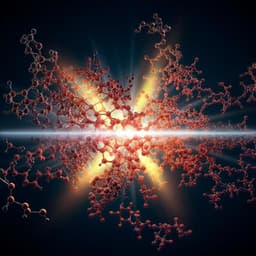
Physics
Activating non-Hermitian skin modes by parity-time symmetry breaking
Z. Lei, C. H. Lee, et al.
This groundbreaking research by Zhoutao Lei, Ching Hua Lee, and Linhu Li explores the fascinating realm of parity-time (PT) symmetry as a design approach for higher-dimensional non-Hermitian states, revealing how directional toggling of the non-Hermitian skin effect can be achieved across various platforms.
Playback language: English
Introduction
Non-Hermitian physics, particularly systems with parity-time (PT) symmetry, has gained significant attention due to its potential for realizing exotic phenomena. PT symmetry, a type of pseudo-Hermiticity, ensures real eigenenergies for PT-unbroken states, maintaining stability by balancing gain and loss. This balance has been experimentally demonstrated in various platforms, including optical, acoustic, circuit, and atomic systems. Recently, the non-Hermitian skin effect (NHSE) has emerged as a crucial phenomenon in non-Hermitian lattices. NHSE leads to the exponential accumulation of eigenstates at the boundaries under open boundary conditions (OBCs), a feature absent under periodic boundary conditions (PBCs). This effect is always accompanied by a complex spectrum under PBCs, indicating broken PT symmetry. However, the potential of PT symmetry in controlling and manipulating NHSE remains largely unexplored. This research aims to fill this gap by establishing a comprehensive framework for utilizing PT symmetry to design and control higher-dimensional non-Hermitian lattices with unconventional dynamics in their bulk, surface, hinge, and corner states. The study will explore how selective activation or breaking of PT symmetry in different sectors allows for the generation and manipulation of diverse higher-dimensional NHSEs, extending the possibilities beyond known phenomena like corner NHSE and hybrid skin-topological effects. The theoretical models presented have potential applications in designing non-Hermitian optical devices and can be extended to classical (electrical circuits) and quantum systems (cold atoms, superconducting circuits).
Literature Review
The paper extensively reviews previous work on PT symmetry in non-Hermitian physics, highlighting its role in ensuring real eigenenergies and enabling stable experimental realizations of exotic phenomena. It cites numerous publications demonstrating PT symmetry in various platforms, including optical, acoustic, circuit, and atomic systems. The literature review then focuses on the recently discovered non-Hermitian skin effect (NHSE), emphasizing its characteristic localization of eigenstates at the boundaries under OBCs, in contrast to the extended states under PBCs. The connection between NHSE and the complex spectrum under PBCs, implying broken PT symmetry, is also discussed. The authors point out the lack of a comprehensive framework for using PT symmetry to manipulate NHSE, motivating their present research.
Methodology
The research employs theoretical modeling using non-interacting lattices to investigate the effects of PT symmetry on NHSE. The core methodology involves systematically breaking and restoring PT symmetry in different sectors (edges, surfaces) of 2D and 3D lattices. A key model used is a 2D extension of the 1D non-Hermitian Su-Schrieffer-Heeger (nH-SSH) model, incorporating a ky-dependent coupling. The Hamiltonian for this model is defined and analyzed, considering different boundary conditions (OBCs and PBCs) along both x and y directions. The concept of generalized PT symmetry is introduced, and its connection to the real and complex nature of the spectrum is explored. The fractal dimension (FD) is used as a quantitative measure to characterize the dimensionality of eigenstates (corner, edge, bulk). To demonstrate directional toggling of NHSE, a parameter β is introduced to interpolate between x-PBCs and x-OBCs, enabling the controlled switching of NHSE between x and y directions. The transition between these states, including the emergence of corner modes, is analyzed using FD and its 1D projections. Another 2D model is introduced to explore the interplay between PT symmetry breaking in edge states and topological effects, leading to a hybrid skin-topological effect. The selective activation/deactivation of NHSE for different branches of edge states is demonstrated by introducing an extra anti-Hermitian term to the Hamiltonian. The dynamics of an initially center-localized state is investigated under different Hamiltonians, revealing the qualitative transitions in state evolution due to the competition between different NHSE channels. The methodology is extended to 3D systems, where selective activation of NHSE in surface and hinge states is investigated. Specific 3D Hamiltonians are defined, and their surface and hinge states are analyzed, demonstrating the richness of PT-activated NHSE phenomena in higher dimensions. The paper also includes a detailed description of the non-Hermitian SSH model and the concept of non-Bloch PT symmetry, explaining how these concepts are used in constructing and analyzing the various models. The detailed expressions for the Hamiltonians, including the boundary hopping terms, are provided, along with descriptions of the methods for calculating the fractal dimension and its projections. The effective Hamiltonians for surface states in the 3D models are derived, showing the connection between PT and CP symmetry breaking and the resulting NHSE phenomena.
Key Findings
The key findings of this paper demonstrate a comprehensive framework for controlling and manipulating the non-Hermitian skin effect (NHSE) through the selective breaking and restoring of parity-time (PT) symmetry. In 2D systems, the study reveals:
1. **Corner NHSE:** A minimal 2D model exhibits robust corner/edge modes localized due to NHSE activated by PT symmetry breaking. The fractal dimension (FD) is used to quantify the localization, with FD ≈ 0 indicating corner localization and FD ≈ 1 indicating edge localization.
2. **Directional Toggling of NHSE:** By tuning boundary hoppings, NHSE can be activated exclusively in the x or y directions, demonstrating directional toggling. Corner modes emerge as an intermediate state during this toggling process.
3. **Selective Boundary NHSE:** A model is presented where PT symmetry is selectively broken only for edge states, leading to a boundary NHSE distinct from bulk NHSE. This results in a hybrid skin-topological effect, where topological edge states are further localized by NHSE.
4. **Anomalous State Dynamics:** The selective activation of NHSE channels leads to unusual non-monotonic state dynamics. A center-localized initial state exhibits different behaviors depending on the presence and direction of NHSE, with transitions between bulk and boundary-dominated dynamics.
In 3D systems, the study shows:
5. **Higher-Dimensional NHSE:** The concepts of directional toggling and selective boundary NHSE extend to 3D, leading to surface and hinge-selective NHSE. The interplay of PT and CP symmetry is also investigated.
The results showcase a rich variety of non-Hermitian skin phenomena driven by selective PT symmetry breaking and restoration. These phenomena are not limited to specific lattice geometries, demonstrating their robustness and potential applicability in diverse platforms.
Discussion
The findings of this study significantly advance our understanding and control of NHSE in non-Hermitian systems. The demonstration of directional NHSE toggling and the emergence of corner modes highlight the potential of using PT symmetry as a versatile design principle for manipulating boundary states. The exploration of selective boundary NHSE and the resulting hybrid skin-topological effect expands the known types of NHSE. The observation of anomalous state dynamics resulting from the competition between NHSE channels points towards the complexity and richness of dynamical behavior in these systems. The extension of these findings to 3D systems further broadens the applicability of the proposed framework. The results have implications for the design of advanced non-Hermitian optical devices exploiting NHSE, offering greater control over light propagation and manipulation. The models presented are readily adaptable to various experimental platforms, promising advancements in diverse areas of physics and engineering.
Conclusion
This work presents a novel paradigm for designing and controlling non-Hermitian skin effects (NHSEs) through the selective manipulation of parity-time (PT) symmetry. The study demonstrates the emergence of various NHSE-related phenomena, including directional toggling, corner modes, and selective boundary NHSE, in both 2D and 3D systems. The findings offer a versatile framework for constructing models with diverse types of NHSE in different system sectors, paving the way for designing advanced non-Hermitian devices. Future research could explore the extension of this framework to other symmetries and the investigation of interacting systems, potentially uncovering further exotic phenomena.
Limitations
The study primarily focuses on non-interacting lattice models. While the findings are insightful and have potential implications for real-world systems, the effects of interactions are not considered. Furthermore, the experimental realization of some of the proposed models might present challenges depending on the specific platform. The analysis primarily relies on numerical simulations; analytical solutions might provide deeper understanding for certain aspects. The focus is on linear lattices; the extension to nonlinear systems could reveal additional complexities and potentially novel phenomena.
Related Publications
Explore these studies to deepen your understanding of the subject.







